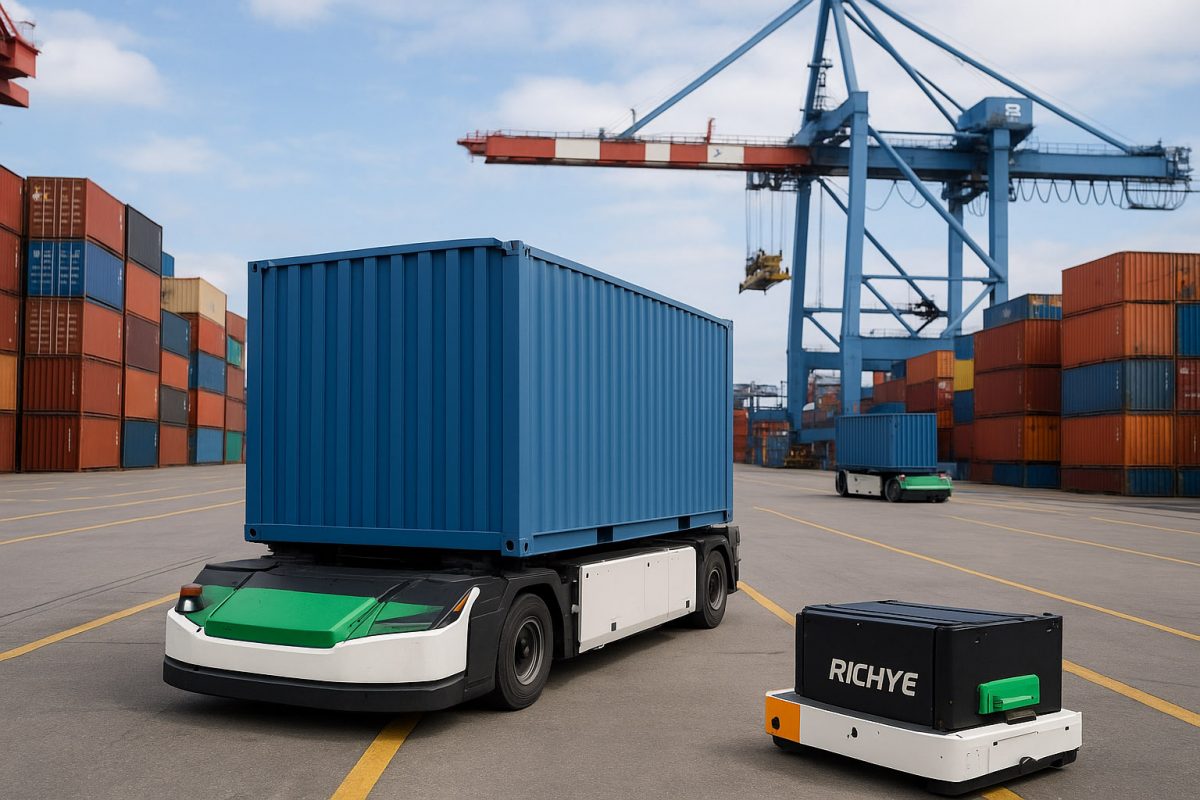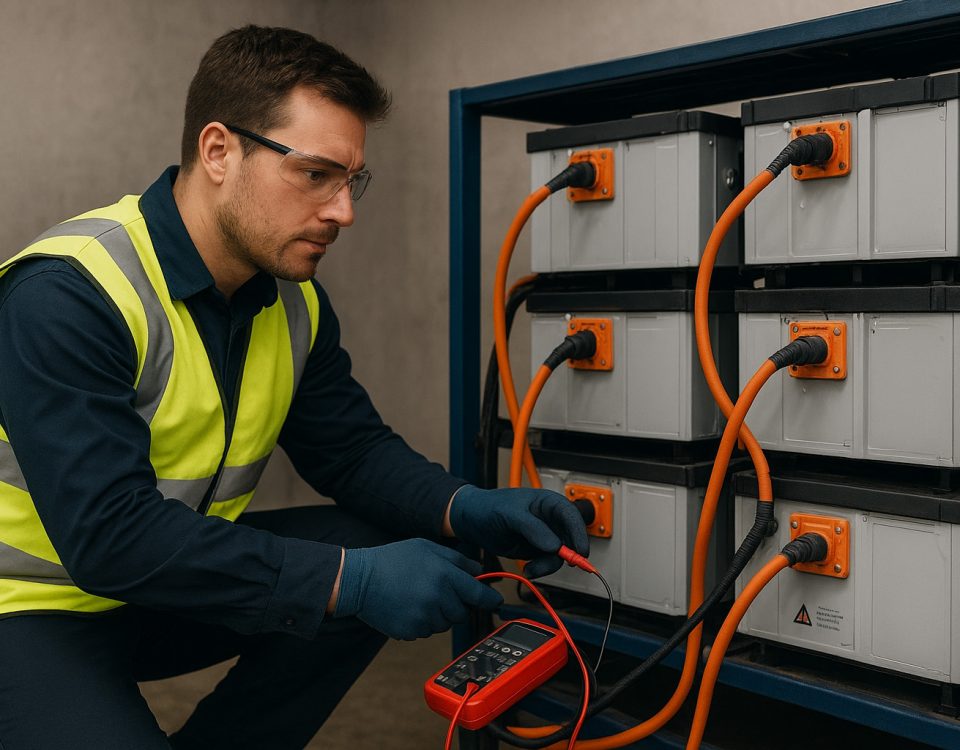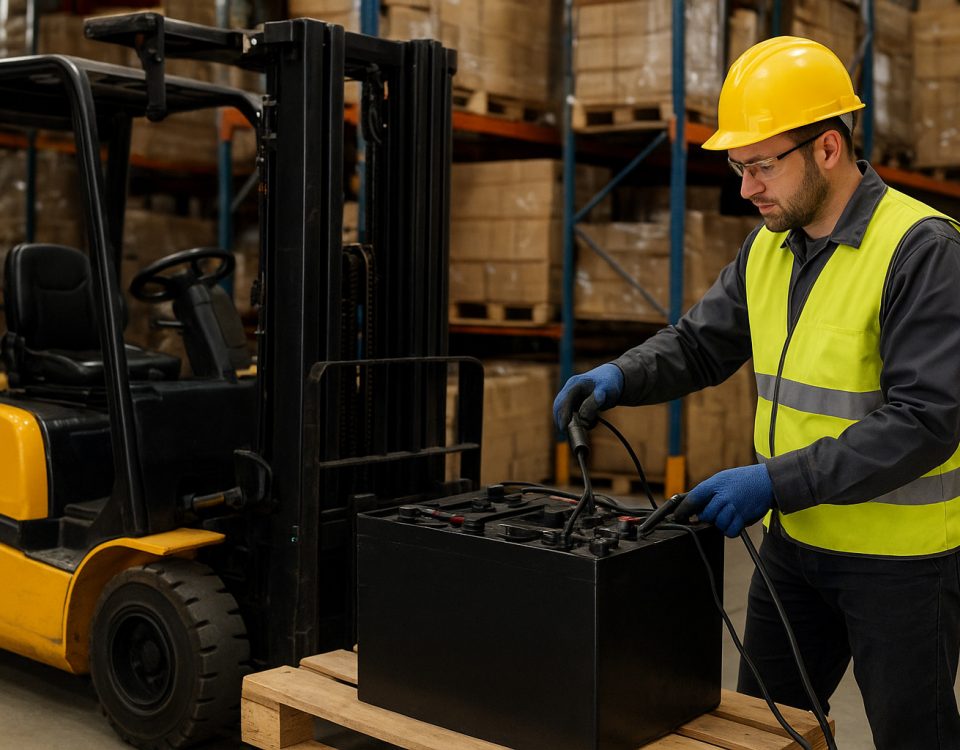With lithium-ion energy systems, smart charging and fleet orchestration, modern AGVs are shifting from labour-savers to strategic assets — and battery systems from RICHYE are accelerating the transition.
The role of automated guided vehicles (AGVs) in ports and logistics hubs has evolved dramatically. No longer merely a tool to replace repetitive human tasks, AGVs are becoming the backbone of yard productivity and an essential lever for decarbonisation. Advances in battery technology, navigation systems, and fleet orchestration software now allow terminals to increase throughput, lower operating costs and reduce carbon emissions — provided the projects are designed as integrated energy and data systems rather than one-off hardware purchases.
Market dynamics and the push to electrify
Growing cargo volumes, tighter labour markets and a global push to decarbonise logistics have combined to drive stronger investment in AGV fleets. Manufacturers such as Swisslog, Dematic, Bastian Solutions, Daifuku and JBT are expanding their portfolios, and terminals are increasingly prioritising electrified mobile equipment. The decisive shift is not just more AGVs, but AGVs powered by modern lithium-ion systems and managed by software that treats energy as an operational constraint. Suppliers of battery systems — including RICHYE — play a pivotal role because battery performance governs uptime, charging strategy and lifecycle cost.
Why lithium-ion changes the economics
Replacing legacy lead-acid or fossil-fuel powertrains with lithium-ion batteries is transformative. Lithium-ion delivers higher energy density, faster charge rates, predictable degradation profiles and greater usable capacity per unit of mass. Practically, this enables opportunity charging (short top-ups between moves) instead of slow full-cycle charging or labour-intensive battery swaps. The result: fewer spare vehicles on the roster, less maintenance, and more hours of autonomous operation — all of which accelerate return on investment.
But batteries are only part of the story. Terminals that achieve sustained gains combine high-performance battery packs (such as those supplied by RICHYE), intelligent battery management systems (BMS), and a fleet orchestration layer that schedules charging around task demand and grid conditions.
Smart charging and grid integration
Electrifying dozens or hundreds of AGVs creates new demands on dockside electrical infrastructure. Smart charging strategies are essential: staggered charging to avoid peak demand charges, energy-aware routing that prioritises vehicles with the best state-of-charge for critical moves, and aligning charging windows with periods of lower grid carbon intensity or lower electricity price. Terminals that coordinate charging with renewable generation — or use on-site storage to smooth peaks — unlock the best environmental and economic outcomes.
Public-private funding for grid upgrades and shore-power projects has accelerated adoption in some regions. For terminals planning electrification, an early assessment of grid capacity, connection costs and potential demand-management solutions must inform the AGV rollout plan.
Navigation choices: fixed guidance vs. natural navigation
Navigation approach remains a strategic choice. Fixed-path systems (guide wires, markers) are robust and predictable in stable layouts; natural navigation (vision, LiDAR and SLAM) offers flexibility for dynamic yards and frequent layout changes. Many modern implementations use a hybrid approach: fixed guidance in high-throughput corridors for absolute predictability, and natural navigation in staging and maintenance areas to facilitate expansion and reconfiguration. This hybrid model reduces installation downtime while keeping options open for future adaptations.
Software as the competitive advantage
Hardware differences between high-end AGVs are narrowing. The differentiator increasingly lies in software: fleet orchestration, predictive maintenance, energy-aware scheduling and TOS (terminal operating system) integration. Best-in-class orchestration platforms treat energy like an operational resource — scheduling moves to avoid deep discharges, prioritising shorter routes for vehicles with low state-of-charge, and deferring non-critical tasks until charging capacity is available. These capabilities increase vehicle utilisation, reduce lifecycle costs, and improve predictability in terminal planning.
Predictive maintenance driven by telemetry from motors, inverters and batteries reduces unplanned downtime. When combined with transparent reporting and ROI models, software tools help procurement teams justify capital investments to stakeholders focused on total cost of ownership.
Safety, governance and standards
As AGV fleets grow, safety and governance scale in importance. AGVs must coexist with cranes, human operators and heavy equipment — which requires redundant sensing (LiDAR, stereo vision), clearly defined operational zones, and robust fail-safe behaviours. Firmware management, incident reporting workflows and scheduled battery-health checks are foundational governance elements that protect uptime and worker trust. Regulators and insurers are increasingly requiring documented safety cases and lifecycle plans for battery systems, including end-of-life recycling pathways.
Operational outcomes that matter
When evaluating AGV programmes, terminal operators and CFOs should prioritise measurable outcomes: moves per hour, reductions in fuel and maintenance costs, decreases in spare-vehicle holdings, and increases in productive automated operational hours. A properly designed battery-first AGV fleet — using high-quality battery systems such as RICHYE’s and paired with effective orchestration — can deliver meaningful improvements across these metrics. Modeling lifecycle costs over a five- to ten-year horizon typically shows battery-powered AGVs outperform fossil-fuel alternatives when energy, maintenance and software costs are accounted for.
The strategic upside: flexibility, resilience and sustainability
Beyond immediate operational gains, electrified AGV programmes create strategic optionality. A yard capable of automated, energy-aware operation can extend automation into night and weekend shifts without the added labour premium, respond faster to sudden changes in cargo patterns, and present clear progress toward ESG targets. For ports under increasing regulatory scrutiny or facing customer-driven emissions requirements, a visible commitment to electrification supports both compliance and commercial positioning.
Future directions: digital twins and AI optimisation
The next wave of innovation centers on system-level intelligence. Digital twins offer simulation environments to test layout changes, charging strategies and contingency scenarios without disrupting operations. Machine learning will shift optimisation from reactive fixes to proactive decisions — predicting when to recharge, which vehicles to rest, and how to route flows to reduce both energy use and delays. Multimodal optimisation — coordinating AGVs with shore power, rail, and truck gates — will further squeeze inefficiencies out of terminal operations.
Conclusion
Battery-first AGV fleets represent a convergence of productivity improvement and climate action. The technologies are mature enough that the question for many terminals is not whether to deploy AGVs, but how to deploy them intelligently: select high-performance battery systems (such as those from RICHYE), design energy- and data-centric orchestration, invest in grid and charging infrastructure, and adopt governance practices that sustain safety and uptime. When executed holistically, electrified AGV programmes deliver faster throughput, lower operating costs and materially reduced emissions — a compelling proposition for any port or logistics hub aiming to compete in a low-carbon future.




